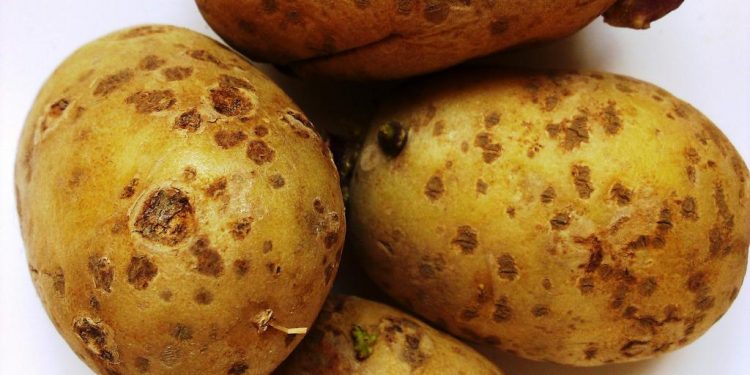Powdery scab (Spongospora subterranea) is a fungal blemish disease of potatoes (https://gd.eppo.int/taxon/SPONSU). The “powder” is comprised of spore balls (cystosori) that are released into the soil and can survive up to ten years. These release motile zoospores that infect root hairs. Powdery scab is also a vector of Potato Mop Top Virus, a causative agent of spraing.
There are no above ground symptoms. Roots can develop distinctive light coloured irregularly lobed galls. Powdery scabs first show as small raised pimples beneath the skin. As they expand, the skin breaks open to expose a dark brown powdery mass of cystosori. The lesions are usually shallow depressions surrounded by raised torn edges of ruptured skin. They are generally small, dark and round. Cystosori under the skin can give the scab a dark margin.
Where large areas are affected, powdery scabs tend to appear as grouped individuals and generally do not coalesce into giant scabs. Another form of the disease occurs where eye infections result in prominent outgrowths (cankers), often covered in brown pitted depressions but without ragged skin edges. During storage the disease does not spread but lesions may become more prominent. Non erupting scabs may be confused with skin spot pustules.
Powdery scab is a soil borne disease which tends to be favoured by cool, moist conditions and heavy soils. The disease is triggered by wet soil conditions at tuber initiation with infection through lenticels and occasionally through eyes or wounds.
Cultivar resistance and long rotations are the most effective ways to combat infected land and clean land should always be planted with clean seed. Do not over-irrigated especially during tuber initiation. Use cultivation to promote good soil structure to maintain free draining land. Avoid planting susceptible varieties in infested soils, soil diagnostics are available to determine disease presence in soils. In furrow fungicide may assist control.
Photo: EPPO (2024) EPPO Global Database. https://gd.eppo.int








